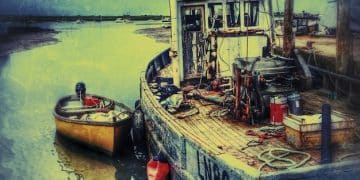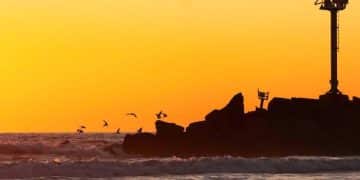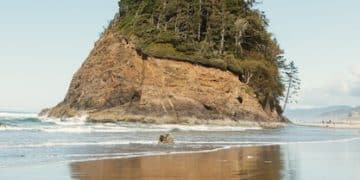Coastal Clean-Up Initiatives: Volunteer Opportunities & Impact Report
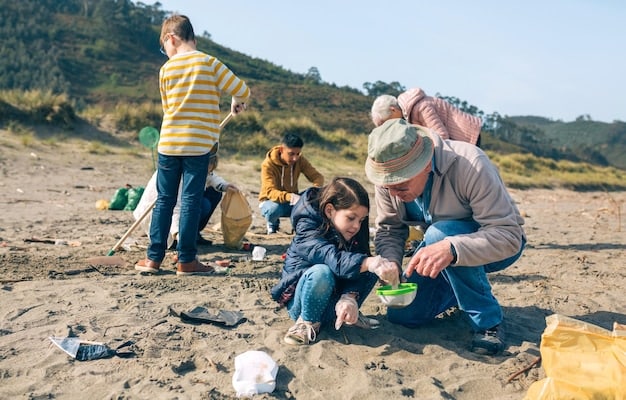
Coastal clean-up initiatives offer vital volunteer opportunities to combat marine pollution, significantly improving environmental health and biodiversity in coastal regions through organized efforts and community engagement, as detailed in comprehensive impact reports.
In a world increasingly aware of environmental challenges, the health of our oceans and coastlines has emerged as a critical concern. Among the most direct and impactful ways individuals can contribute to this global effort are coastal clean-up initiatives: volunteer opportunities and environmental impact report insights reveal their profound importance. These initiatives are not just about picking up trash; they embody a collective commitment to preserving natural beauty, protecting marine life, and fostering healthier ecosystems for future generations.
The Urgency of Coastal Preservation: Why Clean-Ups Matter
Our coastlines, vibrant interfaces between land and sea, are facing unprecedented threats from pollution. Plastic waste, fishing gear, and myriad other anthropogenic debris accumulate at alarming rates, posing grave dangers to marine biodiversity and human health. Understanding the sheer scale of this problem is the first step toward effective intervention.
Marine debris, especially plastic, fragments into microplastics, entering the food chain and eventually reaching our own plates. This chemical ingress poses long-term health risks that are only just beginning to be understood. Beyond direct ingestion, marine animals often become entangled in larger debris or mistake plastic for food, leading to injury, starvation, and death. The aesthetic appeal of beaches is also severely degraded, impacting tourism and recreational activities crucial to many coastal economies.
Understanding the Sources of Coastal Pollution
To effectively combat coastal pollution, it’s essential to identify its primary sources. While some debris originates directly from marine activities like shipping and fishing, a significant portion comes from land-based sources, carried by winds, rivers, and storm drains into the ocean. This includes:
- Single-use plastics: Bottles, bags, food wrappers, and styrofoam containers.
- Fishing gear: Abandoned, lost, or discarded fishing nets, lines, traps, and buoys (often referred to as “ghost gear”).
- Industrial and everyday waste: Chemical runoff, sewage, and general litter from urban areas.
- Microfibers: Tiny plastic threads shed from synthetic clothing during washing.
The Ripple Effect of a Clean Coastline
Cleaning a section of beach might seem like a small act in the face of such a monumental problem, but the cumulative effect is profound. Every piece of trash removed prevents further environmental degradation. Moreover, clean-up events raise public awareness, inspiring others to adopt more sustainable practices and fostering a sense of collective responsibility. They serve as tangible reminders of the interconnectedness of human actions and environmental health.
From a biological perspective, clearer waters and debris-free habitats support healthier marine populations. Nesting sea turtles can lay eggs without obstruction, migratory birds find safer foraging grounds, and vital coral reefs, often smothered by debris, can begin to recover. The economic benefits are also significant, as pristine beaches attract tourism and support local businesses reliant on healthy coastal environments.
Volunteer Opportunities: How to Get Involved in Clean-Up Initiatives
Becoming an active participant in coastal clean-up efforts is easier than many imagine, with a spectrum of opportunities available for individuals and groups alike. These initiatives thrive on community engagement, offering versatile roles that cater to varying commitment levels and interests.
Most coastal clean-up events are organized by non-profit environmental organizations, local community groups, or governmental bodies. These organizations often provide all necessary equipment, including gloves, trash bags, and safety briefings, making participation accessible even for first-time volunteers. The experience is not only about contributing to a cause but also about connecting with like-minded individuals and learning more about marine conservation.
Finding and Joining a Local Clean-Up Event
The first step is locating an event near you. Many national and international organizations maintain searchable databases or calendars of upcoming clean-up drives. Websites like those of the Ocean Conservancy or local park services are excellent starting points. Additionally, social media platforms and local community centers often announce volunteer opportunities for coastal clean-ups.
- Online registries: Check major environmental organization websites for statewide or national event listings.
- Local community boards: Libraries, community centers, and local government websites often post about local clean-up days.
- Social media groups: Many regional environmental groups use platforms like Facebook to organize and promote their events.
- School and university programs: Educational institutions often organize clean-up events as part of their environmental or community service initiatives.
Beyond the Beach: Diverse Volunteer Roles
Volunteer opportunities extend beyond simply picking up trash on the sand. Many initiatives require support for logistics, data collection, and even educational outreach. These diverse roles ensure that volunteers can contribute based on their skills and preferences, making clean-ups more efficient and impactful.
For example, some volunteers might be involved in sorting collected debris for recycling, documenting the types and quantities of litter for scientific analysis, or engaging with beachgoers to raise awareness. Specialized roles often exist for those with first aid training or experience in leading groups. This variety highlights that every volunteer, regardless of their background, can play a significant part in the success of these vital environmental efforts.

Measuring Success: Environmental Impact Report Data Analysis
Beyond the immediate visual improvement of a cleaner coastline, the true measure of a clean-up initiative’s success lies in its long-term environmental impact. This is where meticulous data collection and comprehensive environmental impact reports become indispensable. These reports transform anecdotal observations into quantifiable evidence, allowing organizations to track progress, identify pollution hotspots, and inform policy changes.
Data collected during clean-ups typically includes the types, quantities, and locations of debris removed. This information is then compiled, analyzed, and often shared with scientific institutions and policymakers. High-quality data helps researchers understand pollution trends, pinpoint industrial contributors, and assess the effectiveness of current waste management strategies. Without such empirical evidence, advocacy for stronger environmental protections would lack the necessary scientific foundation.
Key Metrics in Environmental Impact Reports
Environmental impact reports often focus on several key metrics to gauge the effectiveness of clean-up efforts and the overall health of coastal environments. These include a variety of indicators that help paint a comprehensive picture of the pollution problem and the impact of intervention.
- Total weight of debris collected: A straightforward measure of the raw amount of pollution removed.
- Types of debris found: Categorizing debris helps identify prevalent items, such as plastics, fishing gear, or cigarette butts.
- Source identification: Tracing debris back to its origin (e.g., land-based, marine-based) informs prevention strategies.
- Impact on local wildlife: Documenting entanglement or ingestion incidents highlights the direct harm to ecosystems.
- Changes in pollution rates over time: Long-term data allows for trend analysis, showing whether efforts are leading to reductions.
From Data to Action: Informing Policy and Practice
The insights gleaned from environmental impact reports are crucial for guiding future actions. For example, if reports consistently show a high prevalence of plastic bottles, it can inform campaigns pushing for stronger recycling infrastructure or even bans on single-use plastics. Similarly, an abundance of ghost fishing gear can prompt dialogue within the fishing industry about responsible gear management.
Furthermore, these reports provide compelling evidence for policymakers to enact and enforce environmental regulations. They can serve as powerful tools in lobbying efforts for increased funding for waste management, the development of biodegradable alternatives, and international cooperation on marine pollution. Ultimately, the data collected by volunteers on beaches globally forms the bedrock of meaningful and lasting environmental change.
Case Studies: Exemplary Coastal Clean-Up Initiatives
To truly appreciate the power of collective action, examining specific examples of successful coastal clean-up initiatives offers invaluable insight. These case studies highlight diverse approaches, scales of operation, and the remarkable impact that dedicated individuals and organizations can achieve. They demonstrate that whether local or global, systematic clean-ups are a cornerstone of marine conservation.
These initiatives often feature innovative techniques, strong community partnerships, and a clear vision for a healthier future. They also serve as models, inspiring new groups to form and adopt best practices in their own regions. From vast international movements to focused local efforts, each clean-up contributes uniquely to the larger tapestry of ocean protection.
The Ocean Conservancy’s International Coastal Clean-up (ICC)
The ICC is arguably the largest volunteer effort for ocean health, spanning more than 150 countries. Every year, millions of volunteers comb beaches, coastlines, and underwater sites, meticulously recording every piece of trash they find. The data collected by the ICC is unparalleled in its scope, providing a global snapshot of marine debris. This data has been instrumental in advocating for policy changes, from single-use plastic bans to improved waste management systems worldwide.
The strength of the ICC lies in its collaborative nature, engaging diverse stakeholders from individuals to corporations and governments. Its long history also provides a robust dataset for trend analysis, allowing scientists to track changes in marine debris composition over decades. The ICC is a testament to what can be achieved when a global community unites for a common environmental cause.
Surfrider Foundation’s Beach Cleanup Program
The Surfrider Foundation, with its network of chapters across the globe, actively organizes beach clean-ups as a cornerstone of its mission to protect oceans, waves, and beaches. Their clean-up program is often integrated with their broader advocacy efforts, using the collected data to push for specific local and regional policy changes, such as plastic bag bans or improved stormwater management.
Surfrider’s approach emphasizes empowering local communities to take ownership of their coastlines. Beyond the immediate clean-up, they often host educational events during these gatherings, informing participants about local environmental issues and how they can continue to make a difference beyond the clean-up day. This holistic approach fosters long-term stewardship and environmental awareness.
Local Grassroots Efforts: The Power of Community
While large organizations lead massive campaigns, countless smaller, local grassroots initiatives make a profound difference. These might be a group of friends regularly cleaning their favorite cove, a neighborhood association adopting a stretch of beach, or school groups organizing annual clean-ups. These local efforts often have the most immediate and visible impact on specific areas.
Their strength lies in their agility and deep connection to the specific needs of their local environments. They can quickly mobilize in response to local pollution events, and their close-knit communities often lead to higher volunteer retention and a stronger sense of shared purpose. These local clean-ups, though individual in scope, collectively form the backbone of a global movement for coastal health.
Challenges and Future Directions for Clean-Up Initiatives
Despite their undeniable success and vital role, coastal clean-up initiatives face several significant challenges. These challenges range from practical logistical hurdles to the overarching issue of addressing the root causes of pollution. Understanding these obstacles is critical for shaping the future direction of clean-up efforts and ensuring their sustained effectiveness. While clean-ups are reactive, proactive measures are equally, if not more, important.
One primary challenge is the sheer volume of debris. As plastic production escalates globally, the influx of new waste sometimes outpaces the efforts to remove it. Furthermore, certain types of debris, like microplastics, are incredibly difficult to collect once dispersed. Addressing these complexities requires a multi-faceted approach that integrates clean-up with upstream prevention strategies.
Logistical and Operational Hurdles
Organizing and executing large-scale clean-ups involves considerable logistical planning. Issues such as equipment availability, safe disposal of collected waste, and volunteer safety are constant concerns. Managing hazardous waste encountered during clean-ups also requires specialized protocols and resources. Moreover, securing funding and consistent volunteer turnout can be ongoing challenges for many organizations.
- Waste disposal: Ensuring collected debris is properly sorted and recycled, rather than simply landfilled.
- Volunteer retention: Maintaining a consistent base of engaged volunteers requires continuous outreach and appreciation.
- Safety concerns: Protecting volunteers from sharp objects, hazardous materials, and environmental risks.
- Accessibility: Reaching remote or difficult-to-access coastal areas where pollution often accumulates unseen.
Addressing the Root Causes: Beyond the Clean-Up
While clean-ups are essential, they are ultimately reactive measures. The long-term solution to marine pollution lies in addressing its root causes: overproduction and consumption of single-use plastics, inadequate waste management infrastructure, and a lack of corporate responsibility. Future efforts must increasingly focus on prevention, extending beyond picking up trash to advocating for systemic change.
This includes supporting policies that reduce plastic production, promoting circular economy models, investing in robust recycling and waste treatment facilities, and educating the public on sustainable consumption. The data gathered from clean-ups provides crucial evidence for these advocacy efforts, strengthening the case for comprehensive upstream solutions. Integration of clean-up data with scientific research is key to identifying and tackling these fundamental issues.
The Broader Impact: Education, Advocacy, and Policy Changes
The impact of coastal clean-up initiatives extends far beyond the physical removal of debris. These events serve as powerful platforms for environmental education, raising awareness about marine pollution and fostering a deeper connection to nature among participants. They also provide invaluable data that fuels advocacy efforts, leading to tangible policy changes at local, national, and even international levels.
By engaging diverse communities, clean-ups amplify voices in the environmental movement, demonstrating public demand for healthier oceans. They transform abstract environmental issues into concrete, personal experiences, inspiring sustained engagement and responsible behavior. The cumulative effect is a more informed and empowered citizenry, ready to champion ocean conservation.
Educating the Next Generation
Clean-ups often involve school groups and young volunteers, providing a hands-on learning experience about environmental stewardship. Children who participate gain a vivid understanding of the impact of litter, sparking an early commitment to responsible waste management and conservation. This direct engagement is far more effective than classroom lectures alone, instilling values that can last a lifetime.
Furthermore, many clean-up organizations supplement their events with educational materials, workshops, and discussions. These programs delve into topics like the dangers of microplastics, the importance of recycling, and the role of sustainable lifestyle choices in preventing pollution. By making environmental learning experiential, clean-ups cultivate a new generation of ocean advocates.
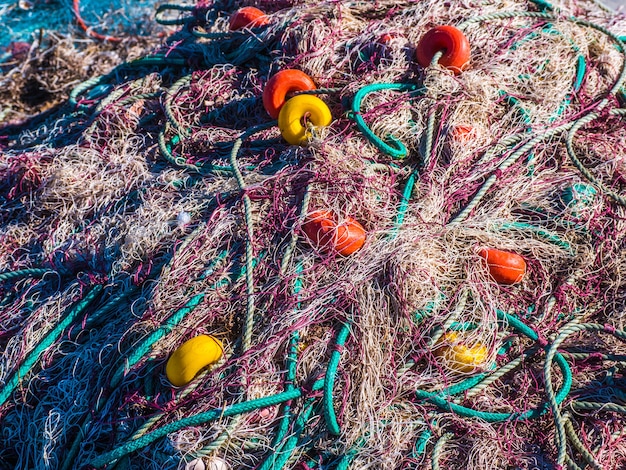
Catalyzing Policy and Corporate Change
The data collected during clean-ups is a goldmine for policymakers and environmental advocates. Reports detailing the most common types of debris, their brands, and their origins provide irrefutable evidence for regulating specific products or industries. This data can inform legislation on single-use plastics, packaging design, and extended producer responsibility.
Simultaneously, public awareness generated by clean-ups puts pressure on corporations to adopt more sustainable practices. Companies are increasingly being held accountable for their environmental footprint, leading to innovations in packaging, greater use of recycled materials, and investments in cleaner production processes. The visibility of clean-up efforts transforms consumer sentiment into market demand, demonstrating that environmental responsibility is also good business.
Sustainable Futures: Integrating Clean-Ups with Broader Conservation
For coastal clean-up initiatives to achieve their full potential, they must be seamlessly integrated into broader conservation strategies. This means moving beyond episodic clean-ups towards a continuous, holistic approach that combines waste removal with preventative measures, ecosystem restoration, and long-term public engagement. The future of coastal preservation lies in this integrated model, ensuring lasting positive change.
This comprehensive view recognizes that clean coastlines are not isolated achievements but rather components of healthy marine and terrestrial ecosystems. Consequently, efforts should span across disciplines, linking pollution control with biodiversity protection, climate change adaptation, and sustainable resource management. The goal is not just to clean up, but to create resilient and thriving coastal environments.
From Reactive to Proactive: A Preventative Mindset
The transition from a purely reactive clean-up model to a more proactive, preventative one is essential. This involves investing in infrastructure for waste management, promoting public education on waste reduction, and advocating for policies that curb the flow of pollutants at their source. Innovations in material science and packaging design also play a crucial role in reducing the availability of harmful plastics.
For example, initiatives promoting reusable alternatives, banning certain single-use plastics, and implementing effective Extended Producer Responsibility (EPR) schemes where manufacturers are liable for the end-of-life management of their products, are all vital components of a preventative strategy. Clean-ups can then become less about removing overwhelming amounts of trash and more about maintaining pristine conditions and responding to accidental pollution events.
Community Stewardship and Long-Term Engagement
Sustained environmental health depends on ongoing community stewardship. Clean-up initiatives are excellent entry points for this, but building a durable culture of conservation requires more. Encouraging “adopt-a-beach” programs, supporting local environmental groups, and providing continuous educational resources can foster a deep-seated commitment to coastal protection among residents and visitors alike.
Ultimately, the vision for a sustainable future involves communities that view their coastlines as shared treasures, actively participating in their care, and advocating for their protection. Coastal clean-ups are a powerful catalyst in this transformation, turning concern into action and individual efforts into collective impact, ensuring the beauty and health of our shores for generations to come.
| Key Point | Brief Description |
|---|---|
| 🌍 Pollution Impact | Marine pollution, especially plastic, harms biodiversity and human health; clean-ups mitigate these risks. |
| 🤝 Volunteer Roles | Opportunities range from debris collection to data sorting, suiting various skills and commitment levels. |
| 🔬 Data-Driven Impact | Collected data informs policy, tracks trends, and highlights pollution sources, driving systemic change. |
| 🌱 Holistic Approach | Clean-ups are part of broader conservation: education, advocacy, and proactive prevention strategies. |
Frequently Asked Questions About Coastal Clean-Up Initiatives
▼
Common items found include single-use plastics like bottles, bags, straws, and food wrappers. Other frequent discoveries are cigarette butts, fishing gear (nets, lines), foam fragments, and various forms of industrial and everyday litter. The specific types can vary depending on the location and proximity to urban or industrial areas.
▼
Volunteers collect and categorize debris, recording types, quantities, and locations. This data is compiled into environmental impact reports. These reports help identify pollution hotspots, track trends, understand pollution sources, and provide crucial evidence for policymakers and researchers to develop effective prevention and mitigation strategies.
▼
While major organized clean-up events often occur during specific seasons (e.g., fall for International Coastal Cleanup), many organizations and local groups hold clean-ups year-round. Check local environmental group websites, community calendars, or national conservation organization portals for ongoing opportunities, which can be weather-dependent.
▼
Volunteers should wear sturdy, closed-toe shoes, gloves, and sun protection (hat, sunscreen). It’s advisable to bring water, snacks, and a first-aid kit. Avoid touching hazardous materials. Always follow the instructions provided by event organizers, who typically conduct safety briefings before clean-ups begin to ensure a safe experience for all participants.
▼
To start your own initiative, begin by researching local permits or regulations for beach access and waste disposal. Gather a small group of friends or family, plan a safe route, and ensure you have necessary supplies like gloves and trash bags. Consider partnering with a local organization for guidance and support, especially for proper waste handling and reporting.
Conclusion
Coastal clean-up initiatives represent a powerful nexus of direct environmental action, community engagement, and scientific data collection. They offer critical volunteer opportunities that not only visibly enhance the beauty of our coastlines but also generate invaluable insights for environmental impact reports. These reports, in turn, drive informed advocacy and systemic policy changes, moving us closer to a future where our oceans are cleaner and healthier. By participating in or supporting these initiatives, whether on a global scale or within a local community, individuals contribute to a vital movement for marine conservation, underscoring the collective responsibility we share for our planet’s invaluable coastal ecosystems.
